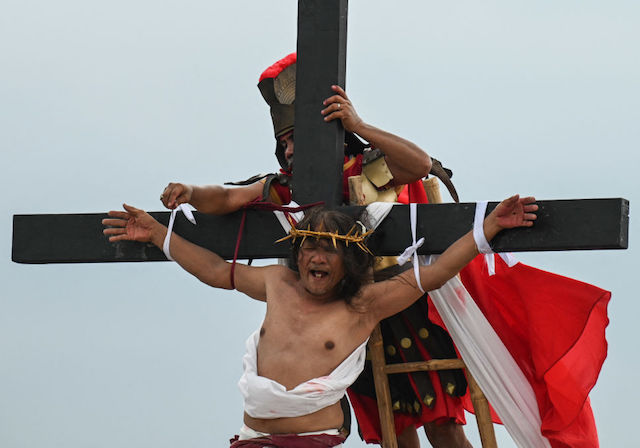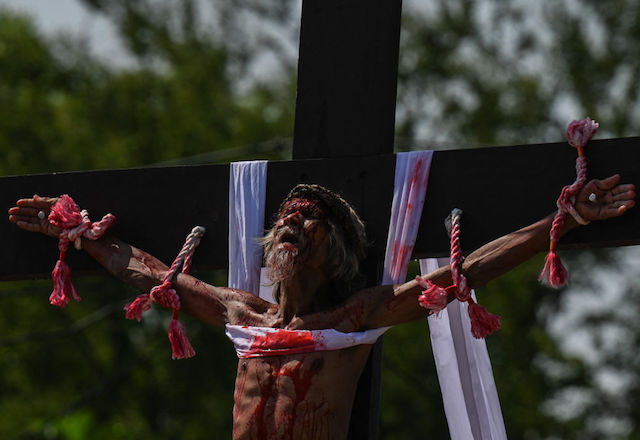20,000 Christians Watch Live Crucifixions to Mark Good Friday in Philippines
A crowd of an estimated 20,000 people convened in San Fernando, Pampanga, Philippines on Friday to observe the tradition of live crucifixions to mark the occasion of Good Friday, when Christians around the world observe the crucifixion of Jesus Christ in anticipation of his resurrection on Easter Sunday.
The Philippines has a storied tradition of believers participating in acts of self-flagellation as a form of penance on Good Friday. In addition to the crucifixions, many people, most of them young men, also partake in street processions in which they use bamboo sticks and other items to beat their backs as they march, leaving a trail of blood behind them.

Penitents flagellate themselves during Good Friday as part of Holy Week celebrations in San Fernando, Pampanga province on March 29, 2024. (Photo by JAM STA ROSA / AFP)
The crucifixions, unique around the world, tend to attract the most headlines, however – and concerned discouragement from the Catholic Church, the dominant religious entity in the Philippines. The small group of faithful who participate in the crucifixions, however, insist that they are a necessary part of their faith, the fulfillment of personal promises to Jesus or an expression of gratitude for miracles in their life.
The Filipino Inquirer reported that 20,000 people visited San Fernando to observe the tradition this year. Those crucified spent about ten minutes on the cross. They also, as part of the rite, carry the cross to the site of the crucifixion.
The newspaper identified ten people, all men, who were crucified this year. The crucifixion of women is not unheard of, however, and, while less common, has occurred in the past.
The most prolific participant in the tradition is Ruben Enaje, a carpenter who was crucified for the 35th time on Friday. Enaje has become the face of the tradition, which he says he began in the 1980s after suffering a three-story fall and, calling God’s name on the way down, fell unscathed.
LOOK: Ruben Enaje is nailed to the cross for the 35th time as part of his vow on Good Friday in Brgy. San Pedro Cutud, Pampanga.
According to Enaje, 63, he started his passion every Holy Week since 1986 after he miraculously survived an accident in his work. #SemanaSanta2024 |… pic.twitter.com/xG5JV5OOGB
— ABS-CBN News (@ABSCBNNews) March 29, 2024
“Before I started this vow, I had an accident in 1985. I fell off a building and miraculously didn’t suffer any injuries. When I came around I thanked the Lord by letting myself get crucified. I started in 1986. I paused it only during the COVID pandemic,” Enaje told the Filipino news outlet ABS-CBN.

Philippine Christian devotee Ruben Enaje performs his 35th re-enactment of the crucifixion of Jesus Christ on Good Friday in San Fernando, Pampanga province on March 29, 2024. (Photo by JAM STA ROSA / AFP)
In an interview this week, Enaje said that he had dedicated many of his crucifixions to pray for the health and safety of family members, among other blessings, but that he had essentially run out of things to pray for, as God had granted all his wishes.
“Now I don’t have any personal prayer because the Lord has given me everything I’ve asked for, plenty of jobs for my family,” Enaje told the outlet.
Enaje has said on multiple occasions, including on Good Friday 2023, that he would retire, but has continued to return. The carpenter told the Filipino Inquirer that, this year, he mostly partook in the tradition to ensure that it would not end.
“I’m doing this for our village so that the tradition would not be stopped,” he asserted. The newspaper reported that local officials asked him to be crucified again this year.
Following Enaje is Danilo Ramos, who marked his 31st year on the cross; Joselito Capili, who was crucified for a 19th time, and Fernando Mamangun, who is on year 27, and Wilfredo Salvador, who was crucified for a 16th time on Friday, among others.
Local officials identified two men, Crisanto Ramos and Ubardo Yumang, who were crucified for the first time, continuing the tradition.
Salvador, a 67-year-old fisherman, has insisted that he will never retire from being crucified.
“I will keep doing this while I’m alive, for as long as my body is able to do it. That is my vow,” he told France24 this year, stating that the damage to his body is “nothing” and sometimes takes little more than a day to heal.

Philippine Christian devotee Wilfredo Salvador takes part in the re-enactment of the crucifixion of Jesus Christ on Good Friday in San Fernando, Pampanga province on March 29, 2024. (Photo by JAM STA ROSA / AFP)
Catholic leaders have discouraged the practice, but failed to halt it completely.
“It’s no longer necessary to shed blood because the shedding of blood was done by Jesus Christ for us,” Archbishop of Lingayen-Dagupan Socrates Villegas said last year. “We don’t have to hurt ourselves anymore because we cannot add to the merit of Christ’s passion.”
Observers at the event insist that it has merit, however, to witness crucifixions in live flesh.
“If you were to merely read it in the Bible you would not really understand. In action it is clearer for us to see how he suffered for us,” local Marilyn Lovite, who typically attends the event, told France24 this year.
Christians have been holding reenactment plays of the story of Jesus Christ for centuries, but the tradition of crucifying people in Pampanga reportedly began in 1961 with local Arsenio Añosa, who is believed to have been crucified 15 times. The tradition occurred uninterrupted through 2020, when anti-Catholic President Rodrigo Duterte – who encouraged people to “kill bishops” and claimed he was sexually assaulted by a priest as a child – used the Wuhan coronavirus pandemic to cancel it. Duterte also outlawed processions and self-flagellations, but many across the country ignored the ban, and Duterte did not enforce it.
The tradition returned without restrictions in 2023 under the current president, Ferdinand Marcos, Jr.





Comments are closed.